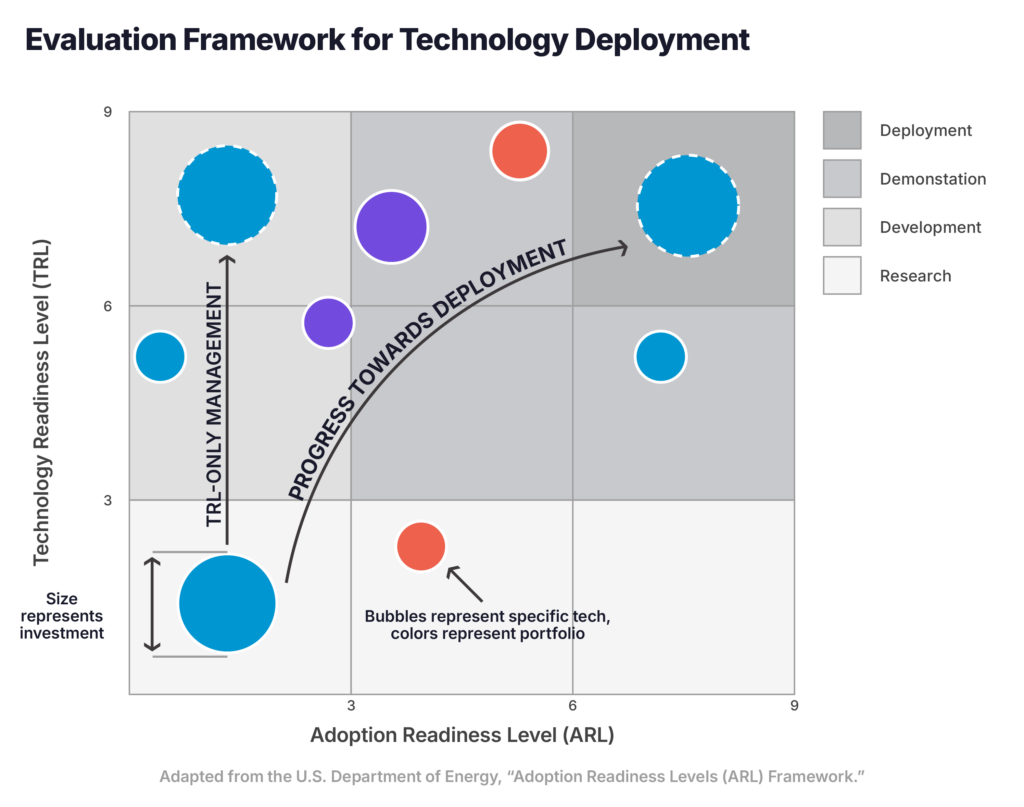- Blog
Innovation Toward Commercialization: Sharpening the Department of Energy’s Ability to Foster Adoption Readiness
- Written by Lindsey Griffith
- 4 minute read
In business, certainty is essential. Without it, projects fail, investor support for innovative technologies wavers, and U.S. competitiveness weakens. The U.S. Department of Energy (DOE) today is on its strongest-ever footing to provide investor certainty, making the investments in clean energy research, development, demonstration, and deployment necessary for the U.S. to remain a global energy leader. This clean energy mission has been affirmed through bipartisan legislation signed by multiple Presidents. Achieving an energy system ready to power our country’s innovation economy will require continued public sector innovation and investment. We must deploy the highest-quality products and solutions to bolster American competitiveness and support diverse and changing communities over the long term.
New clean energy technologies face no fewer than four pivotal inflection points on the way to deployment (Fig. 1). The DOE has an imperative to play in helping clean energy technologies overcome these hurdles. The agency can lead the way by using and modifying available tools to increase its programs’ impact and participation rate. At the same time, the DOE needs to continue to develop new tools to help those in government and in business move clean energy technologies through the innovation pipeline. Superior tools are necessary to support a clean energy technology transition from discovery through to deployment.
How to Improve the Innovation Pipeline
The most recent major federal energy laws outfitted DOE with a robust set of policies and programs to help commercialize cutting-edge technologies. Nevertheless, policymakers and agency officials should improve and expand the DOE’s toolsets to support innovation and movement toward commercialization. These approaches must include:
- Better-designed funding opportunities
- More flexibility in government programs
- Funding to meet the needs of rapid new technology developments
- Flexible spending options to support technologies through rapid changes in adoption readiness
- Stronger commitments from the public sector to clean technology deployment
Federal policymakers should also mitigate the unintended consequences of commercial readiness requirements on recipients of federal support. Requiring prospective awardees to provide massive letters of credit, proven track records on similar projects, balance sheets that can withstand significant risks, and cost-share capabilities may unintentionally weed out smaller and potentially innovative players in addition to the “unserious” projects that these requirements are intended to reduce.
Meanwhile, cross-departmental initiatives and programs designed to support small-scale pilot projects should be used to ensure that requirements and funding are sufficiently flexible and available to a varied set of private sector investors and companies.
While the DOE should still identify and address technical barriers to deployment, many additional challenges confront innovative new energy technologies. The DOE Office of Technology Transitions (OTT)’s recent addition of Adoption Readiness Levels (ARLs) to the innovation lexicon reflects the DOE’s recognition that American innovators also face many non-technical barriers. Alongside the tracking of Technology Readiness Levels (TRLs), adoption readiness is a helpful evaluation framework to assess projects’ progress in addressing many of the top risks on the path to commercialization, such as market acceptance and license to operate. Further coordination and strategic planning — within and between the Office of the Under Secretary for Infrastructure (S3), the Office of the Under Secretary for Science and Innovation (S4), ARPA-E, and now the Foundation for Energy Security and Innovation (FESI) — will be necessary to overcome real-world deployment challenges.
Going forward, Congress should closely monitor the Department’s work to impact adoption readiness for clean energy technologies. DOE offices across the department should apply the ARL framework or a similar decision matrix to identify how the department can better execute on its mission, as well as work to share a commercial and adoption-oriented perspective with key federal and industry leaders. Meanwhile, innovation-minded investors, civil society, industry both large and small, regulators, and other policymakers must prioritize addressing barriers to clean energy technology readiness and adoption.

America’s global leadership in energy technology is at stake. The DOE’s mission to partner with private sector leaders to commercialize clean energy technology has never been more essential. Navigating adoption and technology readiness challenges will define where the United States ends up in this race to the top.